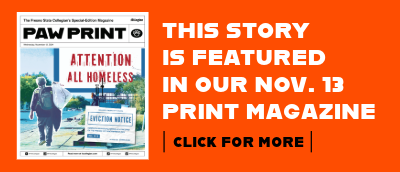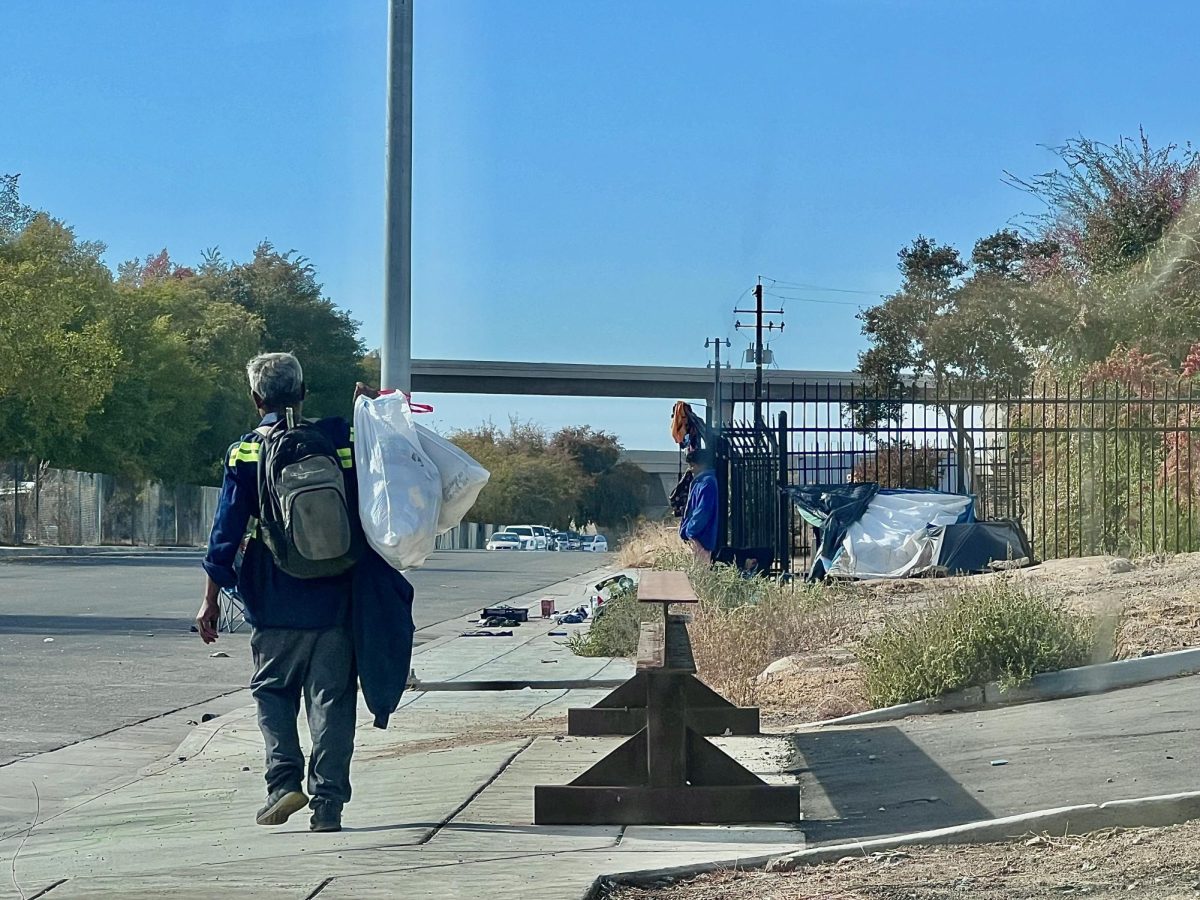Bryce Beckford, a 39-year-old homeless man, spends his days scavenging for recyclables in Fresno, hoping to scrape together enough for a meal. For the past five months, he has lived on the streets, navigating the constant threat of violence and the struggle for basic survival.
He starts his day by visiting a Starbucks every morning. He arrives before dawn to grab a cup of coffee and find a warm place to sit.
“Some days it’s really hard, and some days you get left alone. I’ve had things stolen from me. I’ve been held up at gunpoint and at knifepoint,” Beckford said.
In late September, city leaders moved to impose a citywide encampment ban to combat the rise in homelessness.
Since 2015, Fresno County has seen a steady increase in the number of homeless individuals with an estimated 4,493 people experiencing homelessness in 2023.
“You never feel safe out here,” Beckford said. “I stay outside. There is no shelter, and there is no really safe place to be at, like, I have to find a different place to take cat naps.”
Beckford’s situation reflects the growing challenge in Fresno, where homelessness has reached a crisis point. His troubles were exacerbated when he lost his apartment after losing his job. Now he spends his nights moving from place to place in search of safety.
“Unfortunately, I was unable to keep the place,” Beckford said. “When I got laid off, they let me slide for four months before they put me out. I tried everything within my power to save it, but I couldn’t…I lost everything.”
The struggle to find shelter is an ongoing issue for Beckford, who has been waitlisted for months at local shelters, which are often at full capacity.
“They told me the shelters are too full,” he said. “I’ve been trying to get help, but I can’t get in.”
Shelters across the city, such as the Fresno Mission and the Dakota EcoGarden, have seen an influx of people in need of services.
The Fresno Mission
Nathan Freeland, chief strategy officer for the Fresno Mission, which provides emergency shelter and case management services to the homeless, acknowledges the difficulties facing the city’s homeless population.
“Since the encampment ban went into effect, we’ve seen more people coming in, particularly families,” Freeland said. “We opened up our warming center earlier than usual because of the increased need, and it’s been crucial to help those who have been displaced.”
Fresno native Jesse Cordova has also recently found himself homeless after returning from living out of state.
“I sleep in a vehicle, but that ended yesterday,” Cordova said. “I got housed immediately. I’m not thrilled about it, I can go back into my vehicle and live much more comfortable but if you follow the process, then the reinforcement of people that are in those particular positions to help you will continue to help you and guide you through.”
Cordova admitted that it was difficult to find help in the past. He recounts memories of his upbringing that include a close-knit family willing to help each other when needed, even when resources were tight.
“I see a lot of my family members growing apart,” Cordova said. “I remember as a child my grandparents inviting relatives from other countries to sleep on the floor.”
Now that Cordova faces housing instability, he says those traditions are long gone.
“I go knock on my relative’s [door] today and say hey, I haven’t been here for 48 years, can I sleep on your floor, they’re like [no],” Cordova said. “They know I’m here and they know I’m homeless. I probably have over 120 family members between my mother and father’s family. And I’ve probably had only one family member say come sleep at my house.”
The Fresno Mission, which has been operating for 75 years, has five campuses in the region. The newest campus is currently under construction, with plans to triple its capacity for families. However, the city’s shelter system is struggling to keep up with demand.
According to Freeland, as of Oct. 31, 104 families were waitlisted for shelter, and the new facility, which will open in January, is expected to be full within days.
“The problem is so big that even with tripling our capacity, we’ll still have a waitlist,” Freeland said. “The need is far greater than what we can provide right now.”
The Fresno Mission is also working on innovating its services as it looks to add outreach that is tailored to the younger population focusing on the ages of 18-24.
“So we’re now in the process of designing a $13 million building that’ll be out front, on the other side, opposite of the Family Center, and our biggest, newest initiative is working with youth bottom, which is preventative,” Freeland said.
The city’s shelters say they are doing what they can to provide services like case management, addiction recovery support and job training. But Freeland emphasizes that just providing a roof over someone’s head isn’t enough to address the root causes of homelessness, which include mental health issues, substance abuse and financial instability.
“It’s not just about housing,” Freeland said. “You can’t solve homelessness by just giving people a place to stay. You have to address the broader issues like addiction, trauma and joblessness. Until that happens, homelessness will continue to be a persistent problem.”
Cordova agrees that the city’s streets present many dangers, especially for those who live in them.
“It’s dangerous too, for those people to get raped, killed and murdered,” Cordova said. “And yeah I appreciate [the shelters]. It’s all stuff that I’m becoming keenly aware of.”
Another significant issue caused by the encampment clearances, Freeland said, is that many homeless individuals lose important documents like identification cards and medical records, which can further complicate their ability to access services.
“We’ve seen clients come through here who have lost everything in a sweep — their IDs, their personal belongings, everything,” Freeland said. “It’s frustrating because we’re trying to build relationships with these individuals, but every time they’re displaced, it makes it harder to help them.”
The Dakota EcoGarden
Another avenue for aid is the Dakota EcoGarden.
While smaller than some other shelters, the program’s EcoVillage initiative provides residents with access to an address and stable short-term housing. The main house provides two rooms and the attached lot provides 13 encampment spaces, with four of them being small eco-friendly living structures.
“People can stay here for twelve months and work on getting their life together,” said volunteer coordinator Caryn Kochergen. “Getting a job, getting a resume…you can build up some money and find another place to live.”
A $20 monthly fee is asked of residents but it can be retroactive if needed on a case-by-case basis depending on employment status. Kochergen hopes this helps residents feel more independent and capable of getting back on their feet.
The project also features communal kitchens, bathrooms and washing utilities along with an on-site community garden that residents can care for and use to grow produce to cook.
“The residents are actually in charge of everything,” Korchogan said. “They go out and they work in the garden, they harvest the garden. They also interview the prospective residents because they’re going to be living together and working together.”
The garden uses water that is recycled from the shower drainage and washing machines to irrigate the plants including sister crops, corn, beans and squash.
These crops are planted in companionship because they help each other grow, providing root stabilization and shade.
In earlier years, the facility has been subjected to dangerous situations. Because of this, they’ve had to implement additional safety measures.
To live there, one cannot be a registered sex offender, and one must be sober and willing to collaborate on a recovery plan.
“There are people here trying to stay off drugs,” said vice president Gerry Bill. “What was happening was they would come here to hide out from their drug dealers. And their drug dealer would find out they’re here and come and walk onto the property…for that reason, we can only deal with a portion of the homeless population.”
While the EcoVillage offers stable shelter, their funding is limited.
“We just get donations from individuals and a handful of churches in the community and they keep us going every year,” Bill said. “We don’t have any government grants or anything like that.”
The shelter has housed over 147 people since its inception in 2013, and they are actively working on adding more living spaces.
On Aug. 10, 2023, the shelter celebrated its 10th anniversary and the city of Fresno declared the day Dakota EcoGarden Day.
Bill said the program takes inspiration from other eco-friendly shelters in the state. He and his partner, founder Nancy Waidtlow, are hopeful about the future of the initiative.
“It’s a partial solution,” Bill said. “But there could be a hundred of [these shelters]. Our vision is that there could be many like us. The advantage of keeping it small is that things are manageable.”
The two also expressed concern about the city’s involvement in fixing its homelessness crisis.
“I’m kind of disgusted with the city right now,” Waidtlow said. “They don’t do what they could do with people who are wanting to maybe use a part of their property for something like this.”
Regarding the encampment ban, Bill doesn’t see it as a solution.
“That’s no solution,” he said. “It just chases people from one vacant lot to another, basically. It doesn’t actually house them.”
Longtime resident and operations manager Beverly Barnes said she found shelter after her husband passed away.
“I was on the street for a year, I was pushing my shopping cart with what little belongings I had,” Barnes said.
Barnes said she encourages others who are struggling with homelessness to seek help.
“I encourage them to come over to check it out,” Barnes said. “It’s a good place to be and it’s safe. I’d try to get them to come over here and straighten out their lives a little bit…get off the streets and better themselves.”
Local shelters have been keystones in Fresno as they’ve helped to rehabilitate hundreds of individuals and families over several decades. But with the number of homeless individuals locally and statewide increasing every year, the battle against homelessness wages on.







Phizzle FoShizzle MyNizzle • Nov 13, 2024 at 10:27 pm
I stayed in a shelter for 3 going on 4 years because I was compliant with the rules but they kept telling me I wasn’t going to be house because I need to get rid of my emotional support animals, I refuse because I’m allowed to have my emotional support animals covered by the fair housing act and they’re lettered by my doctor for my schizophrenia, psychotic disorder, major depression and they kept telling me to get rid of him and finding ways to kick me out then one day I have my wife first incident I had since I’ve been there and it wasn’t even a big argument they told me just separate for a minute and I did that and I still came and told me I had to leave and my wife still stays in the shop I have gotten all paperwork by myself they did not help me so they were upset because I got reasonable accommodations and get an apartment.
They kick me out and checked my emotional part and I was out into the streets I now stay in the street and everybody always says I choose to be in the streets like if I was sitting at home in my warm apartment watching my on-demand cable and join my lights waiting for my warm cooked food and I thought to myself you know what this isn’t hard enough babe get the sleeping bag we’re going outside.
A lot of us around here because physically impaired mentally impaired and financially impaired we are people too and the government treats us like rats, throw us out in the streets with no plumbing to watch up or you toiletries and then complaining on how we do it while surviving, but want to talk about equal rights but for who; they really are making homeless illegal so they can get the rest of the homeless grant money that was issued to take care of the homeless by passing the buck and now homeless are getting arrested that’s going to cough the taxpayer money so they can keep the 16 million dollars that was granted to take care of the homeless so they can keep the 16 million dollars that was granted to take care of homeless and shelters and now a taxpayers have to pay for the homeless incarceration when it could have just cost the government money not citizens.
And 16 million for the mission they only take care of homeless person one night at a time and let you join the program and not too many people are willing to join the program that 16 million could have went back into the shelter if you’re wondering what happened to that money that was given for the shopping list so that way it didn’t pass on to the taxpayers but the City of Fresno and a lot of the cities in California are greedy and want that government money and don’t care who has to pay for it write Newsome!